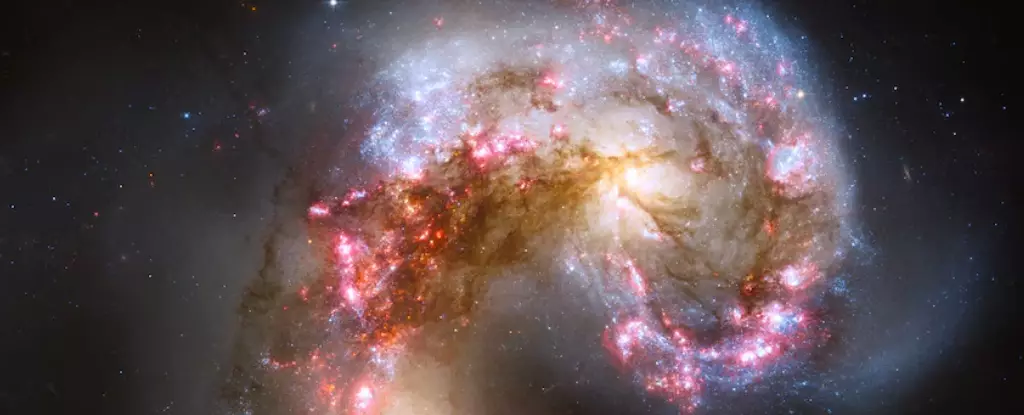The vastness of the Universe continues to inspire awe, with each new discovery revealing just how much remains unexplored. Recent studies have provided groundbreaking insights into one of the long-standing enigmas in astrophysics: the formation of massive elliptical galaxies. The groundbreaking research published in Nature by a collaborative team of astrophysicists marks a pivotal moment in understanding the evolutionary pathways that led to these unique galactic structures.
The Dichotomy of Galaxies
Astronomers generally categorize galaxies into two broad groups—spiral and elliptical. Spirals, like our familiar Milky Way, are characterized by their rich gas content, which supports ongoing star formation within their rotating discs. On the other hand, elliptical galaxies present a stark contrast. These structures are typically larger, rounder, and are not actively forming new stars, with most stars having formed over 10 billion years ago. The question that has long baffled scientists is how these massive elliptical galaxies evolved from their presumably flatter, disc-shaped progenitors.
Essentially, when we examine the timeline of the Universe, particularly during the period spanning 10 to 12 billion years ago, we encounter a conundrum. Cosmological models suggested that galaxies were forming within large discs, which contradicts the presence of modern-day massive elliptical galaxies. This raised critical questions regarding the mechanisms that might have reshaped the galaxies over billions of years.
Utilizing data from the Atacama Large Millimeter/submillimeter Array (ALMA)—one of the most advanced astronomical instruments—researchers have embarked on a detailed analysis of over 100 distant galaxies. This groundbreaking investigation focuses on sites prevalent with star formation at a time when the Universe was merely 2.2 to 5.9 billion years old. Significantly, the presence of dust in these galaxies indicates regions rich in gas, which serves as the building blocks for new stars.
By employing a novel observational technique, scientists discovered that the dust distribution in these galaxies defied previous expectations. Rather than appearing as the flat discs that had been hypothesized, the dust was remarkably compact, suggesting that these distant galaxies bore more resemblance to the three-dimensional structure of elliptical galaxies. This revelation is pivotal as it challenges long-held assumptions and presents new possibilities about the nature of early galaxy formation.
Simulating the Cosmic Evolution
To deepen their understanding, the team leveraged advanced cosmological simulations, interpreting their observations through the lens of computational models. These simulations reveal that the formation processes of elliptical galaxies were influenced by a confluence of factors, including cold gas streams from neighboring galaxies, interactions, and mergers. Such complex dynamics resulted in gas and dust accumulating in the centers of these forming galaxies, leading to active star formation in dense cores, thereby accelerating the transformation into elliptical structures.
The significance of this discovery is profound. Not only does it shed light on the rapid formation of elliptical galaxies, but it also enriches our overall comprehension of the cosmic evolutionary timeline. It highlights the multifaceted processes at play during the early Universe, contributing to the diversity of galaxies observed today.
The success of this research is largely attributed to the innovative approaches adopted in analyzing ALMA’s data. Unlike traditional optical telescopes, which produce images familiar to amateur astronomers, ALMA employs a technique known as interferometry. This method merges signals from multiple antennas, enabling scientists to achieve high-resolution images and precise measurements of galactic properties.
The data accessed for this research was archival and open to the scientific community, epitomizing the spirit of collaboration and shared knowledge that propels modern scientific advancements. The ability to utilize collective data resources underscores the significance of open-source initiatives in accelerating discoveries.
Future Explorations and Observational Horizons
Looking ahead, the field of astrophysics is set for further transformative explorations. Upcoming missions with the James Webb Space Telescope (JWST) and the Euclid space telescope promise to extend our understanding of these ancient elliptical galaxies. The Extremely Large Telescope, with its 39-meter mirror, will likely yield unprecedented details about star-forming regions in the early Universe, alongside improved observations of gas dynamics. These future endeavors will enhance our ability to witness the intricate processes shaping galaxies, providing a clearer picture of the cosmos we inhabit.
The journey into the heart of galaxy formation—specifically investigating elliptical galaxies—remains a crucial frontier in astronomical research. Through innovative methodologies and collaborative efforts, we inch closer to deciphering the complexities of the Universe, revealing the foundational processes that have sculpted the galaxies we observe today. The quest for knowledge is unending, and as we explore deeper into space, we are reminded of just how much there still is to learn.


Leave a Reply